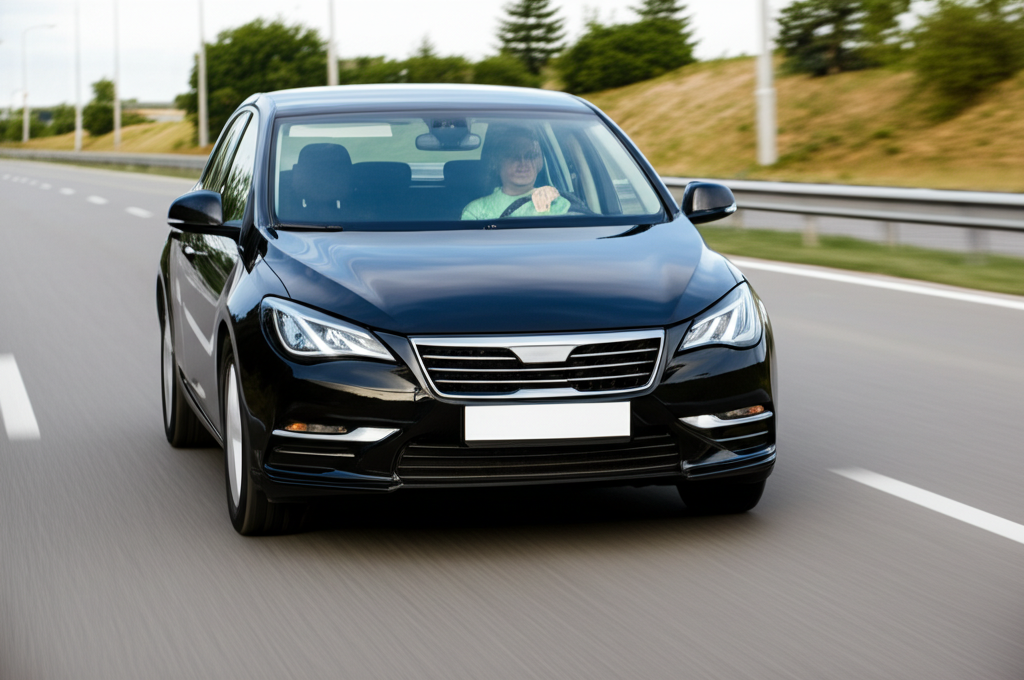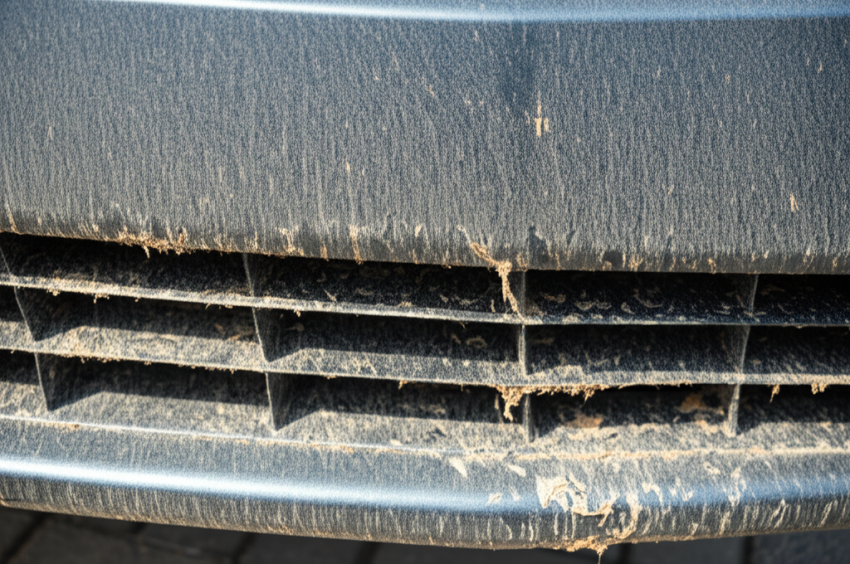You know the feeling. You’ve just meticulously cleaned your car, it’s gleaming under the Thai sun, ready for that long drive – maybe Bangkok to Hua Hin, or Chiang Mai down to the plains. You hit the highway, enjoying the journey. But when you arrive? Disaster. The front bumper, once pristine, is now a gruesome graveyard of splattered insects. Add to that the stubborn black specks of asphalt, tar flung up by trucks, and the tiny pits left by kicked-up gravel. Cleaning it feels like a battle you constantly lose, sometimes even damaging the paint in the process. It’s frustrating, right? It makes you wonder: is there *any* way to protect your car from this relentless assault, especially if you’re frequently clocking up highway kilometers?

Meet Khun Viroj: The Highway Warrior’s Dilemma
Let’s talk about Khun Viroj. He’s a sales manager based in Bangkok, and his territory requires him to drive his Toyota Fortuner up and down Highway 7 towards Pattaya and Rayong several times a week. He loves his car, keeping it immaculate for client meetings. But the highway was his paintwork’s nemesis. “Every week, it was the same story,” Viroj recalls. “Spend Sunday washing the car, looks great. By Tuesday evening, after one round trip, the front end looked like it had been through a war zone. Bugs cemented on, tar spots that needed harsh chemicals, and I started noticing more and more tiny chips from stones. I was worried about permanent paint damage and the car looking old before its time.”
Viroj researched solutions. He considered ceramic coatings but felt they wouldn’t offer enough physical protection against impacts. Repainting was expensive and didn’t solve the root cause. Then he discovered Paint Protection Film (PPF), specifically the Thermoplastic Polyurethane (TPU) variety. Intrigued by promises of self-healing and rock chip resistance, he decided to invest in getting the full front end of his Fortuner wrapped: the entire front bumper, half the hood, the front fenders, and the side mirrors – the areas most vulnerable to highway debris.
The change was immediate and dramatic. “The first trip after the TPU install, I was almost eager to see the damage,” he laughs. “Of course, the bugs were still there. But cleaning? It was night and day. A simple wash took most of them off. The really stubborn ones needed a bit more soap, but they didn’t seem ‘bonded’ like before. The tar spots wiped off easily with a dedicated cleaner, leaving no trace. And the best part? No new stone chips on the protected areas. It’s like having invisible armour. The peace of mind is incredible.”

TPU PPF Explained: Your Shield Against the Road
So, what exactly is this TPU film that worked wonders for Khun Viroj? Paint Protection Film (PPF) is a transparent, durable layer applied directly to your car’s paintwork. While older versions were often made of PVC (Polyvinyl Chloride), modern high-quality PPF uses TPU (Thermoplastic Polyurethane). TPU offers significant advantages:
- Impact Resistance: TPU is flexible and can absorb the energy from small stone chips, gravel, and road debris, preventing them from chipping the paint underneath.
- Scratch Resistance & Self-Healing: Minor scratches and swirl marks (often caused by washing) can disappear with exposure to heat (like the sun or warm water) thanks to the film’s unique properties.
- Stain Resistance: Quality TPU films resist staining from bug splatter, bird droppings, tree sap, and chemicals like tar or acid rain. This makes cleaning significantly easier.
- UV Protection: It contains UV inhibitors to prevent the film itself from yellowing quickly and helps protect the underlying paint from fading due to harsh sunlight – a crucial benefit in Thailand.
- Clarity and Gloss: High-quality TPU is virtually invisible and can even enhance the gloss of the underlying paint.
How does it stack up against other options or doing nothing?
| Feature | TPU Paint Protection Film (PPF) | PVC Wrap Film (Cheaper PPF/Color) | Ceramic Coating | No Protection |
|---|---|---|---|---|
| Impact Protection (Gravel, Chips) | Excellent (Absorbs impact) | Limited to Moderate (Thinner, less flexible) | Minimal (Very thin layer) | None (Paint is vulnerable) |
| Bug & Tar Resistance | Excellent (Easy clean, resists etching) | Good (Easier than paint, can stain over time) | Very Good (Hydrophobic, easy clean, but can still etch if left long) | Poor (Hard to clean, risk of etching) |
| Self-Healing (Minor Scratches) | Yes (Most quality TPU) | No | No (Some claim minor filling) | No |
| Durability / Lifespan | 5-10+ Years (High Quality) | 2-5 Years (Can crack/yellow faster) | 1-5 Years (Depends on type/maintenance) | Paint degrades over time |
| Clarity / Appearance | Virtually Invisible, High Gloss | Can be clear or coloured, may have ‘orange peel’ texture, yellows faster | Enhances Gloss, Invisible Layer | Original Paint Appearance |
| Ease of Cleaning | Excellent (Very smooth, often hydrophobic) | Good | Excellent (Hydrophobic) | Difficult (Contaminants bond) |
| Relative Cost (Installation) | High | Medium | Medium-High | N/A |
| Best Suited For | Maximum physical protection, highway drivers, preserving original paint, long-term ownership | Colour changes, temporary protection, budget constraints | Gloss enhancement, ease of cleaning, chemical resistance (less impact protection) | Low mileage cars, garage kept, budget priority over protection |
For frequent highway drivers in Thailand battling constant bug guts, tar, and stone chips, the table clearly shows why TPU PPF is often the most effective, albeit premium, solution. It directly addresses the physical threats that other solutions can’t fully mitigate.
Voices from the Road: Relief and Satisfaction
Khun Viroj isn’t alone. Many drivers who’ve made the switch share his relief:
“I used to dread washing my car after a trip up North. The bugs baked on the front bumper were a nightmare. Since getting TPU film, it’s almost enjoyable! A quick spray and wipe, and it looks new again. Worth every Baht.” – Preeya, Business Owner, Chiang Mai
“My black Honda Civic showed every single tiny chip from highway driving between Bangkok and Hua Hin. It drove me crazy. The PPF has stopped any new chips appearing on the hood and bumper. The car looks flawless, and I worry less about tailgating trucks kicking up stones.” – Somsak, Family Man, Bangkok
“Living near the coast means salt air plus highway grime. I had PPF installed on my new SUV primarily for the stone chips, but the ease of cleaning off bugs and even tar has been the biggest unexpected bonus. Less scrubbing means less chance of me scratching the paint myself!” – Michael, Expat, Phuket
The common theme? A shift from frustration and worry to relief and satisfaction. The upfront cost is offset by the ease of maintenance, preserved paint condition, and overall peace of mind during those long drives.
Ready to Shield Your Ride?
If you’re tired of the endless cycle of cleaning stubborn highway contaminants, if you cringe every time you hear gravel hit your front end, then TPU Paint Protection Film could be the solution you’re looking for. Protecting your investment not only keeps your car looking great but also helps maintain its resale value. Stop battling the bugs and debris, and start enjoying the drive again.
Want to learn more about how TPU PPF can protect your specific vehicle? Get a personalized consultation and quote from professionals who understand the challenges of Thai roads.
📱 Want to learn more about car wrap & paint protection?
Feel free to reach us on LINE:

🌐 Official Website: https://tpuwraps.com
Frequently Asked Questions (FAQ)
- Q: Will TPU film turn yellow quickly in the strong Thai sun?
- A: High-quality TPU films contain UV inhibitors specifically designed to resist yellowing for many years (typically 5-10 years warranty against yellowing). Cheaper or older technologies might yellow faster. Always choose a reputable brand and installer.
- Q: How difficult is it *really* to clean bugs and tar off TPU film?
- A: Significantly easier than cleaning paint. The film’s surface is non-porous and smoother. Most bugs wash off with regular car soap and water. Stubborn ones might need a dedicated bug remover, but they release much more easily without etching the surface like they can on paint. Tar also lifts more readily with appropriate cleaners.
- Q: Can TPU PPF protect against *all* stone chips?
- A: It offers excellent protection against small to medium stones and gravel commonly encountered on highways. It absorbs the impact energy. However, a very large, sharp stone hitting at high speed can potentially penetrate the film or cause a dent underneath. It’s robust protection, not absolute invincibility.
- Q: What’s the expected lifespan of quality TPU film in Thailand’s climate?
- A: With proper care (regular washing, avoiding abrasive tools), a premium TPU film can last anywhere from 5 to 10 years, sometimes even longer. Many top brands offer warranties within this range covering defects like yellowing, bubbling, or cracking.
- Q: Is TPU PPF worth the cost compared to just repainting the bumper if it gets damaged?
- A: While the upfront cost of PPF is higher than a single repaint, it offers continuous protection. It prevents numerous small chips and stains that accumulate over time. Preserving the original factory paint is also a major factor in maintaining the car’s resale value, which a repaint can diminish. For frequent highway drivers, PPF often proves more cost-effective in the long run by avoiding multiple repaints and preserving value.
The Verdict: Drive Confidently, Arrive Cleanly
For drivers constantly navigating Thailand’s highways, the battle against bug splatter, tar, and stone chips is real and relentless. Our exploration and real-world feedback strongly suggest that high-quality TPU Paint Protection Film is a highly effective solution. It acts as a durable, self-healing, and easy-to-clean barrier, specifically tackling the physical damage and stubborn grime that plagues frequent commuters.
While it represents an investment, the benefits – pristine paintwork, drastically reduced cleaning time, preserved resale value, and invaluable peace of mind – make it a compelling choice for those who spend significant time on the open road. Don’t let highway hazards dictate the condition of your car. Consider shielding it with TPU PPF and reclaim the joy of driving, knowing your vehicle is protected, mile after mile.

